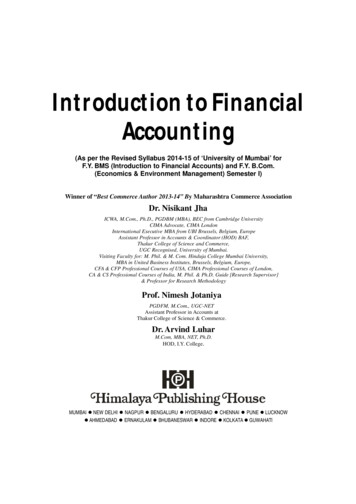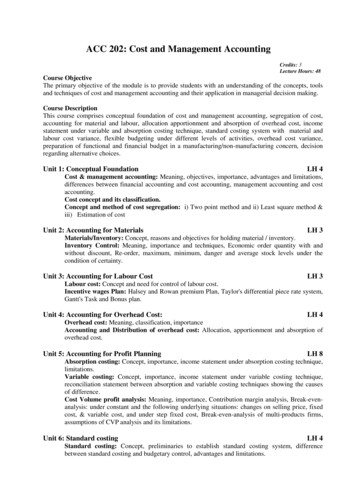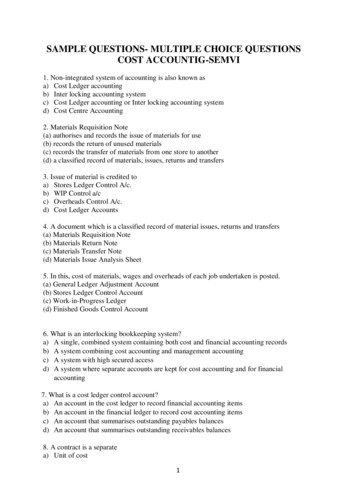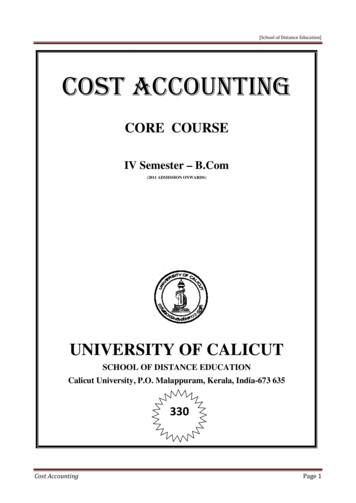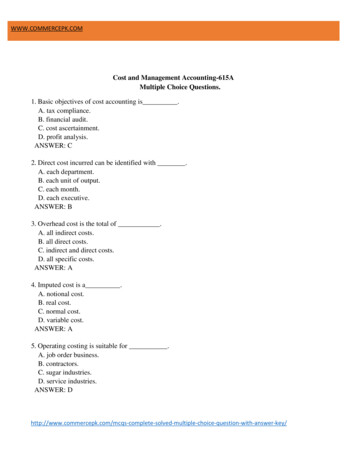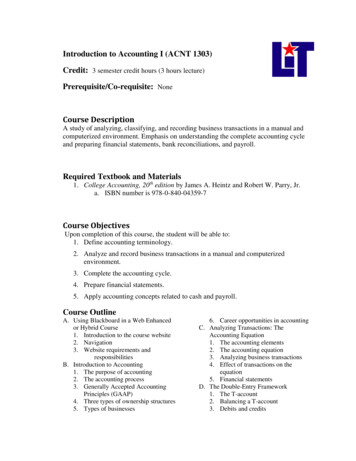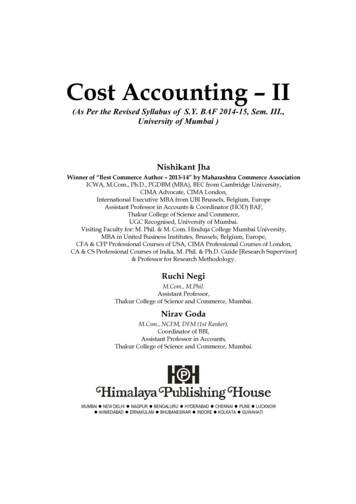
Transcription
Cost Accounting – II(As Per the Revised Syllabus of S.Y. BAF 2014-15, Sem. III.,University of Mumbai )Nishikant JhaWinner of “Best Commerce Author – 2013-14” by Maharashtra Commerce AssociationICWA, M.Com., Ph.D., PGDBM (MBA), BEC from Cambridge University,CIMA Advocate, CIMA London,International Executive MBA from UBI Brussels, Belgium, EuropeAssistant Professor in Accounts & Coordinator (HOD) BAF,Thakur College of Science and Commerce,UGC Recognised, University of Mumbai.Visiting Faculty for: M. Phil. & M. Com. Hinduja College Mumbai University,MBA in United Business Institutes, Brussels, Belgium, Europe,CFA & CFP Professional Courses of USA, CIMA Professional Courses of London,CA & CS Professional Courses of India, M. Phil. & Ph.D. Guide [Research Supervisor]& Professor for Research Methodology.Ruchi NegiM.Com., M.Phil.Assistant Professor,Thakur College of Science and Commerce, Mumbai.Nirav GodaM.Com., NCFM, DFM (1st Ranker),Coordinator of BBI,Assistant Professor in Accounts,Thakur College of Science and Commerce, Mumbai.MUMBAI NEW DELHI NAGPUR BENGALURU HYDERABAD CHENNAI PUNE LUCKNOW AHMEDABAD ERNAKULAM BHUBANESWAR INDORE KOLKATA GUWAHATI
AuthorNo part of this publication may be reproduced, stored in a retrieval system, or transmitted in any form orby any means, electronic, mechanical, photocopying, recording and/or otherwise without the priorwritten permission of the publishers.First Edition: 2014Published by:Mrs. Meena Pandey for Himalaya Publishing House Pvt. Ltd.,“Ramdoot”, Dr. Bhalerao Marg, Girgaon, Mumbai - 400 004.Phone: 022-23860170/23863863, Fax: 022-23877178E-mail: himpub@vsnl.com; Website: www.himpub.comBranch Offices:New Delhi:“Pooja Apartments”, 4-B, Murari Lal Street, Ansari Road, Darya Ganj,New Delhi - 110 002. Phone: 011-23270392, 23278631; Fax: 011-23256286Nagpur:Kundanlal Chandak Industrial Estate, Ghat Road, Nagpur - 440 018.Phone: 0712-2738731, 3296733; Telefax: 0712-2721215Bengaluru:No. 16/1 (Old 12/1), 1st Floor, Next to Hotel Highlands, Madhava Nagar,Race Course Road, Bengaluru - 560 001.Phone: 080-32919385; Telefax: 080-22286611Hyderabad:No. 3-4-184, Lingampally, Besides Raghavendra Swamy Matham, Kachiguda,Hyderabad - 500 027. Phone: 040-27560041, 27550139; Mobile: 09390905282Chennai:No. 8/2, 2nd Madley Street, Ground Floor, T. Nagar, Chennai - 600 017.Mobile: 09345345055Pune:First Floor, "Laksha" Apartment, No. 527, Mehunpura, Shaniwarpeth(Near Prabhat Theatre), Pune - 411 030. Phone: 020-24496323/24496333;Mobile: 09370579333Lucknow:House No 731, Shekhupura Colony, Near B.D. Convent School, Aliganj,Lucknow - 226 022. Mobile: 09307501549Ahmedabad:114, “SHAIL”, 1st Floor, Opp. Madhu Sudan House, C.G. Road, Navrang Pura,Ahmedabad - 380 009. Phone: 079-26560126; Mobile: 09377088847Ernakulam:39/176 (New No: 60/251) 1st Floor, Karikkamuri Road, Ernakulam,Kochi - 682011, Phone: 0484-2378012, 2378016; Mobile: 09344199799Bhubaneswar:5 Station Square, Bhubaneswar - 751 001 (Odisha).Phone: 0674-2532129, Mobile: 09338746007Indore:Kesardeep Avenue Extension, 73, Narayan Bagh, Flat No. 302, IIIrd Floor,Near Humpty Dumpty School, Indore - 452 007 (M.P.). Mobile: 09301386468Kolkata:108/4, Beliaghata Main Road, Near ID Hospital, Opp. SBI Bank,Kolkata -700 010, Phone: 033-32449649, Mobile: 09883055590, 07439040301Guwahati: House No. 15, Behind Pragjyotish College, Near Sharma Printing Press,P.O. Bharalumukh, Guwahati - 781009, (Assam).Mobile: 09883055590, 09883055536DTP by: Nitin GodePrinted at:
SyllabusCost Accounting – Paper IIMethods of Costing Modules at a GlanceSr. No.ModulesNo. ofLectures1.Classification of Costs And Cost Sheets202.Reconciliation of Cost and Financial Accounts103.Contract Costing154.Process Costing15Total60Sr. No1.Modules/ UnitsClassification of Costs and Cost Sheet:Classification of costs, Cost of Sales, Cost Centre, Cost Unit, Profit Centre andInvestment Centre Cost Sheet, Total Costs and Unit Costs, Different Costs fordifferent purpose Simple practical problems on preparation of cost sheet2.Reconciliation of cost and financial accounts:Practical problems based on reconciliation of cost and Financial accounts.3.Contract Costing:Progress payments, Retention money, Contract accounts, Accounting formaterial, Accounting for Tax deducted at source by the contractee, Accountingfor plant used in a contract, treatment of profit on incomplete contracts,Contract profit and Balance sheet entries. Excluding Escalation clause NoteSimple practical problems4.Process Costing:Process loss, Abnormal gains and losses, Joint products and by products.Excluding Equivalent units, Inter-process profit Note – Simple Practicalproblems Process Costing and joint and by products
Paper PatternCredit Based Evaluation System Scheme of Examination(a) Internal of Assessment – 25%Sr. No.25 MarksParticulars1.One periodical class test*20 Marks2.Active participation in routing class instructional deliveries and overallconduct as a responsible learner, mannerism and articulation and exhibitof leadership qualities in organizing related academic activities05 Marks(b) Semester end Examinations – 75%TestMarks75 Marks1. Question Paper Pattern for Periodical Class Test for Courses at UG Programmes written Class20 MarksSr. No.ParticularsMarks1.Match the Column/Fill in the Blanks/Multiple Choice Questions(1/2 Marks each)05 Marks2.Answer in one or two lines (Concept based Questions)(1 Mark each)05 Marks3.Answer in Brief (Attempt any two of the three)(5 Marks each)10 Marks
Question Paper PatternMaximum Marks: 75Questions to be Set: 05Duration: 2 1/2 Hrs.All Question are Compulsory Carrying 15 marks each.Sr. No.Q.1Q.2Q.2Q.3Q.3Q.4Q.4Q.5Q.5ParticularsObjective Questions(a) Sub Questions to be asked 10 and to be answered any 08(b) Sub Questions to be asked 10 and to be answered any 07(*Multiple choice/True or False/Match the column, Fill in the blanks)Marks15 MarksFull Length Practical QuestionORFull Length Practical Question15 MarksFull Length Practical QuestionORFull Length Practical Question15 MarksFull Length Practical QuestionORFull Length Practical Question15 Marks(a) Theory Questions(b) Theory QuestionsORShort NotesTo be asked 05To be answered 0308 Marks07 Marks15 Marks15 Marks15 Marks15 MarksNote: Full length question of 15 marks may be divided into two sub questions of 08 and 07 marks.
Contents1.Cost Sheet1 – 592.Reconciliation3.Process Costing108 – 1874.Contract Costing188 – 24760 – 107
1ChapterCost SheetCost ClassificationThe bases of classifying costs are the nature of cost, function, direct/indirect variability,controllability, normality, capital/revenue, time planning and control, managerial decisions, etc. Theclassification of cost is done based on these factors. The concept of cost center refers to the smallestsegment of activity or area of responsibility for which costs are accumulated. A cost unit is nothing buta unit of output in the production of which the costs are incurred. The techniques of costing can beclassified as historical costing, absorption costing, marginal costing, direct costing, standard costingand uniform costing.Different Basis for Classification of CostCost classification is the process of grouping costs according to their common characteristics. Asuitable classification of costs is very helpful in identifying a given cost with cost centers or cost units.Cost may be classified according to their nature, i.e., material, labour and expenses and a number ofother characteristics. Depending upon the purpose to be achieved and requirements of a particularconcern, the same cost figures may be classified into different categories. The classification of costscan be done in the following ways:1. By Nature or Element2. By Functions3. As Direct and Indirect4. By Variability5. By Controllability6. By Normality7. By Capital and Revenue8. By Time9. According to Planning and Control10. For Managerial Decisions11. Others1. By Nature or Element or Analytical ClassificationThe cost are divided into three categories, i.e., materials, labour and expenses. Furthersubclassification of each element can be done, for example, material into raw material components,and spare parts, consumable stores, packing material, etc.
2Cost AccountingNatureMaterial CostLabour CostOverheads2. By FunctionsIt leads to grouping of costs according to the broad divisions of functions of a businessundertaking or basic managerial activities, i.e., production, administration, selling and distribution.According to this classification, cost are divided as follows:FunctionManufacturing CostCommercial CostManufacturing and Production Cost: This category includes the total costs incurred inmanufacture, construction and fabrication of units of production.Commercial Costs: This category includes the total cost incurred in the operation of a businessundertaking other than the costs of manufacturing and production. Commercial cost may further besubdivided into:(a) administrative cost and(b) selling and distribution cost.3. As Direct and IndirectAccording to this classification, total cost is divided into direct costs and indirect costs. Directcosts are those costs which are incurred for and may be conveniently identified with a particular costcenter or cost unit. The common example of direct costs are materials used and labour employed inmanufacturing an article or in a particular process of production. Indirect costs are those costs whichare incurred for the benefit of a number of cost centers or cost units and cannot be convenientlyidentified with a particular cost center or cost units. Examples of indirect costs include rent of building,management salaries, machinery depreciation, etc. The nature of the business and the cost unit chosenwill determine the costs as direct and indirect. For example, the hire charges of a mobile crane used onsite by a contractor would be regarded as a direct cost since it is identifiable with the project/site onwhich it is employed, but if the crane is used as a part of the services of a factory, the hire chargeswould be regarded as indirect cost because it will probably benefit more than one cost center ordepartment. The distinction between direct and indirect cost is essential because the direct cost ofproduct or activity can be accurately identified with the cost object while the indirect costs have to beapportioned on the basis of certain assumptions about their incidence.4. By VariabilityThe basis for this classification is the behaviour of costs in relation to changes in the level ofactivity or volume of production. On this basis, costs are classified into three groups, viz., fixedvariable and semi-variable.
Cost Sheet3VariabilityFixed CostVariable CostSemi-variableFixed (or Period) Costs: Fixed costs are those which remain fixed in total with increase ordecrease in the volume of output or activity for a given period of time or for a given range of outputfixed costs per unit vary inversely with the volume of production, that is. Fixed cost per unit decreasesas production increases and increases as production decreases. Examples of fixed costs are rent,insurance of factory building, factory manager’s salary, etc. These costs are constant in total amountbut fluctuate per unit as production changes. These costs are known as period costs because these aremostly dependent on time rather than on output. These costs are also termed as capacity costs.Variable or Product Costs: Variable costs are those which vary in total directly in proportion tothe volume of output. These costs per unit remain selectively constant with changes in volume ofproduction on activity. Thus, variable costs fluctuate in total amount but tend to remain constant perunit as production activity changes. Examples are direct material costs, direct labour costs, power,repairs etc. Such costs are known as product costs because they depend on the quantity of output ratheron time.Semi-variable Costs: Semi-variable costs are those which are partly variable. For example,telephone expenses include a fixed portion of monthly charge plus variable charge according to thenumber of calls made. Thus, total telephone expenses are semi-variable. Other examples of such costsare depreciation, repairs and maintenance of building and plant etc.5. By ControllabilityOn this basis, costs are classified into two categories:ControllabilityControllable CostUncontrollable CostControllable Costs: If the costs are influenced by the action of a specified member of anundertaking, that is to say, costs which are at least partly within the control of management, they arecalled controllable costs. An organisation is divided into a number of responsibility centers andcontrollable costs incurred in a particular cost center can be influenced by the action of the managerresponsible for the center. Generally speaking, all direct costs including direct material, direct labourand some of the overhead expenses are controllable by lower level of management.Uncontrollable Costs: If the costs are influenced by the action of a specified member of anundertaking, that is to say, which are not within the control of management, they are calleduncontrollable costs. Most of the fixed costs are uncontrollable. For example, rent of the building isnot controllable and so is managerial salaries. Overhead cost which is incurred by one service sectionor department and is apportioned to another which receives the service is also not controllable by thelatter.Controllability of costs depends on the level of management (top, middle or lower) and the periodof time (long-term or short-term).
4Cost Accounting6. By NormalityOn this basis, the costs are classified into two categories:NormalityAbnormal CostNormal CostAbnormal Cost: It is the cost which is not normally incurred at a given level of output in theconditions in which that level of output is normally attained. It is not a part of cost of production andcharged to Costing Profit and Loss Account.Normal Cost: It is the cost which is normally incurred at a given level of output in the conditionsin which that level of output is normally attained. It is not a part of cost of production.7. By Capital and Revenue or Financial Accounting ClassificationIf the cost is incurred in purchasing assets either to earn income or increase the earning capacityof the business is called capital cost, for example, the cost of a rolling machine in case of steel plant.Through the cost incurred at one point of time, the benefit accruing from it are spread over a numberof accounting years. Revenue expenditure is any expenditure done in order to maintain the earningcapacity of the concern such as cost of maintaining an asset or running a business. Example, cost ofmaterial used in production, labour charges paid to convert the material into production, salaries,depreciation, repairs and maintenance charges, selling and distribution charges, etc. While calculatingcost, revenue items are considered whereas capital items are completely ignored.8. By TimeCosts can be classified as: (i) Historical costs and (ii) Predetermined costs.TimeHistorical CostPredetermined CostHistorical Costs: The costs ascertained after being incurred are called historical costs. Such costsare available only when the production of a particular thing has already been done. Such costs are onlyof historical value and not at all helpful for cost control purposes.Predetermined Costs: Such costs are estimated costs, i.e., computed in advance of productiontaking into consideration the previous periods, costs and the factors affecting such costs. If they aredetermined on scientific basis, they become standard cost. Such costs when compared with actualcosts will give the variances and reasons of variance and will help the management to fix theresponsibility and take remedial action to avoid its recurrence in future.9. According to Planning and ControlCost Accounting furnishes information to the management which is helpful in discharging thetwo important functions of management, i.e., planning and control. For the purpose of planning andcontrol, costs are classified as budgeted costs and standard costs.
Cost Sheet5Planning and ControlMarginal CostOut-of-pocket CostBudgeted CostStandard CostDifferential CostSunk CostManagerial DecisionsImputed CostOpportunity CostReplacement CostAvoidable/UnavoidableCostBudgeted Cost: Budgeted costs represent an estimate of expenditure for different phases orsegments of business operations, such as manufacturing, administration, sales research anddevelopment, for a period of time in future which subsequently becomes the written expression ofmanagerial targets to be achieved. Various budgets are prepared for different phases/segments ofbusiness, such as sales budget, raw material cost budget, labour cost budget, cost of production budget,manufacturing overhead budget, office and administration overhead budget. Continuous comparisonof actual performance (i.e., actual cost) with that of the budgeted cost is made so as to report thevariations from the budgeted cost of the management for corrective action.Standard Costs: The Institute of Cost and Management Accountants, London defines standardcost as “the predetermined cost based on a technical estimate for materials, labour and overhead for aselected period of time and for a prescribed set of working conditions.” Thus, standard cost is adetermination, in advance of production, of what should be its cost under a set of condition.Budgeted costs and standard costs are similar to each other to the extent that both of themrepresent estimates of cost for a period of time in future. In spite of this, they differ in the followingrespects: Standard costs are scientifically predetermined costs of every aspect of business activitywhereas budgeted costs are mere estimates made on the basis of past actual financialaccounting data adjusted to future trends. Thus, budgeted costs are projection of financialaccounts whereas standard costs are projection of cost accounts. The primary emphasis of budgeted costs is on the planning function of management whereasthe main thrust of standard costs is on control. Budgeted costs are extensive whereas standard costs are intensive in their application.Budgeted costs represent a macro approach of business operations because they are estimatedin respect of the operations of a department. Contrary to this, standard costs are concerned witheach and every aspect of business operation carried in department. Budgeted costs arecalculated for different functions of the business, i.e., production, sales, purchase, etc., whereasstandard costs are compiled for various elements of costs, i.e., materials, labour and overhead.
6Cost Accounting10. For Managerial DecisionsOn this basis, costs may be classified into the following categories:Marginal Cost: Marginal cost is the additional cost incurred if an additional unit is produced. Inother words, marginal cost is the total of variable costs, i.e., prime cost plus variable overheads. It isbased on the distinction between fixed and variable costs.Out-of-pocket Costs: This is that portion of the cost which involves payment, i.e., gives rise tocash expenditure as opposed to such costs as depreciation, which do not involve any cash expenditure.Such costs are relevant for price fixation during recession or when make or buy decision is to be made.Differential Costs: If there is a change in costs due to change in the level of activity or pattern ormethods of production, they are known as differential costs. If the change increases the cost, it will becalled incremental cost and if the change results in the decrease in cost, it is known as decrementalcost.Sunk Costs: Sunk cost is another name for historical cost. It is a cost that has already beenincurred and is irrelevant to the decision making process. A good example is depreciation on a fixedasset. Depreciation on a given asset is a sunk cost because the cost (of purchasing the asset) hasalready been incurred (when it was purchased) and it cannot be affected by any future action. Thoughwe allocate the depreciation cost to future period, the original cost of the asset is unavoidable. What isrelevant in this context is the salvage value of the asset not the depreciation. Thus, sunk costs are notrelevant for decision making and are not affected by increase or decrease in volume.Imputed (or Notional) Costs: These costs appear in cost accounts only. For example, notionalrent charged on business premises owned by the proprietor, interest on capital for which no interesthas been paid. When alternative capital investment projects are being evaluated, it is necessary toconsider the imputed interest on capital before a decision is arrived as to which is the most profitableproject.Opportunity Cost: It is the maximum possible alternative earning that will be foregone if theproductive capacity or services are put to some alternative use. For example, if an owned building isproposed to be used for a project, the likely rent of the building is the opportunity cost which shouldbe taken into consideration while evaluating the profitability of the project.Replacement Cost: It is the cost at which there could be purchase of an asset or material identicalto that which is being replaced or revalued. It is the cost of replacement at current market price.Avoidable and Unavoidable Cost: Avoidable costs are those which can be eliminated if aparticular product or department with which they are directly related to, is discontinued. For example,salary of the clerks employed in a particular department can be eliminated, if the department isdiscontinued. Unavoidable cost is that cost which will not be eliminated with the discontinuation of aproduct or department. For example, salary of factory manager or factory rent cannot be eliminatedeven if a product is eliminated.
Cost Sheet711. Other Types of CostsOther CostsFuture CostJoint CostProgrammed CostConversionCostCommitted CostDiscretionary CostFuture Costs: Future costs are those costs that are expected to be incurred at a later date.Programmed Cost: Certain decisions reflect the policies of the top management which results inperiodic appropriations and these costs are referred to as programmed cost. For example, theexpenditure incurred by the company under the Jawahar Rojgar Yojana programme initiated by theprime minister is a programmed cost which reflects the policy of the top management.Joint Cost: Joint cost is the cost of manufacturing joint products up to or prior to the split-offpoint. Cost incurred after the split-off point is called separable cost. Joint cost is common to theprocessing of joint products and by-products till the point of separation and cannot be traced to aparticular product before the point of split-off.Conversion Cost: Conversion cost is the cost incurred in converting the raw material intofinished product. It can be calculated by deducting the cost of direct materials from the production cost.Discretionary Costs: Discretionary costs are those costs which do not have obvious relationshipto levels of capacity or output activity and are determined as part of the periodic planning process. Ineach planning period, the management decides on how much to spend on certain discretionary itemssuch as advertising, research and development, employee training. These costs are amenable foralteration by the management.Committed Cost: Committed cost is fixed cost which results from the decision of themanagement in the prior period and is not subject to the management control in the present on a shortrun basis. They arise from the possession of production facilities, equipment, an organisation set-up,etc. Some examples of committed costs are plant and equipment depreciation, taxes, insurancepremium and rent charges.Cost UnitManagers are often interested in knowing the cost of something. The ‘something’ for which thecost has to be ascertained is known as cost objective or cost object or cost unit. Examples of cost unitsinclude products, activities, department, number of patients treated, sales regions, etc.For example, if a factory produces motor cars, then the cost unit would be motor car because thecosts are all incurred in producing motor cars.Let us take up a more complex situation. Consider a bus operator providing bus services to thepublic between most of the major cities of the country. Suppose the bus operator wants to fix a costunit, what is it?Note that here there is no production, what is provided is a service.
8Cost AccountingEach trip between two cities may be taken as a cost unit. Alternatively, cost per kilometre oftravel may be taken as a cost unit. However, neither of the above cost units relates to the passengerwho buys the service.If the operator wants to fix a price to be charged to each passenger, the above cost units wouldhave to be adjusted further.Assume that a bus cover a distance of 700 km per day carrying 30 passengers on an average, theoutput is 700 30 21,000 passenger kilometres per day. On an average, the passenger kilometrescovered by each bus per week is 1,00,000. The total cost of operation per bus per week is 80,000,the cost per passenger kilometre is 0.80.Cost per passenger kilometre 80 ,000 0.801,00,000The implication is that the bus operator must charge, on an average, over 0.80 per kilometre toeach passenger in order to make a profit.Preparation of Cost SheetCost sheet is a statement designed to show the output of a particular accounting period along withbreak up of costs. It is often considered good to prepare cost sheet with cost data of previous periods.This facilitates comparison and promotes cost control.Cost Sheet(I) Proforma of Cost SheetParticularsOpening Stock of Raw MaterialsAdd: PurchasesAdd: Carriage InwardAdd: Octroi and Customs DutyLess: Closing Stock of Raw MaterialsCost of Direct Materials ConsumedDirect WagesDirect or Chargeable ExpensesPrime CostAdd: Works or Factory Overheads:Indirect MaterialsIndirect WagesLeave WagesBonus to WorkersOvertime WagesFuel and PowerRent and TaxesInsuranceTotal Cost xxxxxxxxxxxxCost Per Unit xxxxxxxxxxxxxxxxxxxxxx
Cost SheetFactory LightingsSupervisionWorks StationeryCanteen and Welfare ExpensesRepairsWorks SalariesDepreciation of Plant and MachineryWorks ExpensesGas and WaterTechnical Director’s FeesLaboratory ExpensesWorks Transport ExpensesWorks Telephone ExpensesAdd: Opening Stock of Work-in-progressLess: Closing Stock of Work-in-progressLess: Sale of Waste ScrapWorks CostsAdd: Office and Administration Overheads:Office SalariesDirector’s FeesOffice Rent and RatesOffice Stationery and PrintingSundry Office ExpensesDepreciation on Office FurnitureSubscription to Trade JournalsOffice LightingsEstablishment ChargesDirector’s Travelling ExpensesConsultants’ FeesContribution to Provident FundPostageLegal ChargesAudit ChargesBank ChargesDepreciation and Repairs of Office EquipmentBonus to StaffCost of ProductionAdd: Opening Stock of Finished GoodsLess: Closing Stock of Finished GoodsCost of Goods SoldAdd: Selling and Distribution xx
10Cost AccountingAdvertisingShowroom ExpensesSalesmen’s Salaries and ExpensesPacking ExpensesCarriage OutwardCommission of Sales AgentsCost of CataloguesExpenses of Delivery VansCollection ChargesTravelling ExpensesCost TendersWarehouse ExpensesCost of Mailing LiteratureSales Managers’ SalariesInsurance of ShowroomSales Directors’ FeesSales Office ExpensesRent of Sales OfficeDepreciation of Delivery VansExpenses of Sales BranchEstablishmentsBranch Office ExpensesTotal Cost/Total of SalesProfit or LossSalesThe following items are to to be ignored in the cost sheet:(a) Advance tax paid(b) Cash discount allowed on sales(c) Dividend paid(d) Dividend received(e) Debenture interest(f) Donation paid(g) Interest received(h) Interest paid on loan(i) Income tax paid(j) Interest paid on bank overdraft(k) Income tax refund(l) Interest on capital(m) Bad xxxxxxxxxxxxxxxxxxxxxxxxxxxxxxxxxxxxxxx
Cost Sheet(n)(o)(p)(q)(r)11Loss on sale of machineryPurchase of computer for officePurchase delivery vanProfit on sale of investmentSale of machineryThe following expenses are excluded from cost sheet:1. Finance Overheads:(a) Interest on Capital(b) Bad Debts.(c) Discount allowed on Sales.2. Income Tax, Advance Tax and Income Tax Provision.The following incomes are excluded from cost sheet:1. Non-operating income such as discount received.Note:The following four items are independent variables and they remain constant unless any changeis given in them:1. Units produced and sold.2. Selling price per unit.3. Variable cost per unit.4. Total Fixed Cost.Direct MaterialDirect LabourDirect ExpensesWorks/FactoryOverheadsPrime CostOffice andAdministrationOverheadsWorks/FactoryCostSelling andDistributionOverheadsCost ofProduction/Costof Goods SoldFig. 1.1: Composition of Selling PriceProfitLossTotal Cost ofSalesSaleValue
12Cost AccountingTable 1.1: Profit TablePercentage on Cost PricePercentage on Sale Price 1 1. 100% 1 1 50% 2 1 2. 50% 2 1 33 1 % 3 3 1 3. 33 1 % 3 3 1 25% 4 1 4. 25% 4 1 20% 5 1 5. 20% 5 1 16 2 % 3 6 1 6. 11.11% 9 1 10% 10 Steps in Preparation of Cost Sheet1. All the costs are classified into Direct Costs or Indirect Costs.2. Items of costs are arranged in the order of first, Material then Labour and in the last expenses.3. All Direct Costs are also termed as Prime Costs. In a Cost Sheet, all the items of Prime Costare recorded first strictly in the order of Material, Labour and Expenses.4. Then all indirect costs also termed as overheads are recorded.5. In case of indirect costs,
"Ramdoot", Dr. Bhalerao Marg, Girgaon, Mumbai - 400 004. Phone: 022-23860170/23863863, Fax: 022-23877178 E-mail: himpub@vsnl.com; Website: www.himpub.com Branch Offices : . Cost classification is the process of grouping costs according to their common characteristics. A


